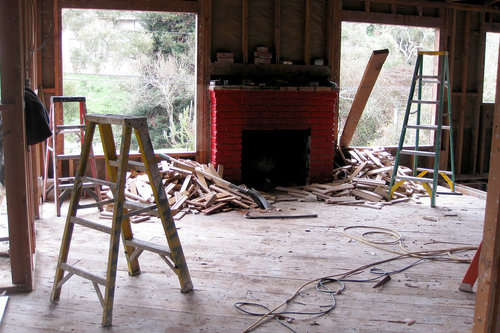Should I Fix My House or Sell It As Is?
When it is time to sell your home, you have two options. You can try to list on the Multiple Listing Service platform (MLS) and use a real estate agent to represent you. Your second option is to sell to a cash buyer who will purchase your home as-is, invest in repairs and then resell it for a profit.
Selling with an agent on the MLS is not the best option for everyone. Especially if you don’t want to spend the time or money fixing it up.
Trying to evaluate all the pros and cons of selling with an agent vs. selling off-market? Check out our Seller Guide: How to Sell a House that Needs Work.
Home buyers prefer modern bathrooms and kitchens. They’re turned off by old heating and water systems, as well as damage and impending maintenance costs such as roof upgrades. Houses in poor condition sit on the MLS for months.
DIY home renovations?
So, why not repair the house yourself to ensure a quick and easy sale on the MLS? Unless you’re a construction professional, this is more challenging than you expect. Home renovation projects are expensive and complicated endeavors that take a long time. Inexperienced remodelers often spend more time and money on the renovation than the value added to the final selling price.
Bottom line: If you are willing to invest in doing the repairs, you’ll need more than just time and money. You’ll also need a lot of know-how, reliable help, and a dose of patience to get the job done right. Here are some tips to consider before you take on any work:
Expect the unexpected
When you pull down the wall or rip up a floor, unfortunate surprises may await you. Here are some common issues that surface during repairs:
- Electrical wiring and plumbing problems are typical in older homes. Outdated electrical wiring is a safety hazard and will need to be updated to code. Expect to pay at least $1,300 to $3,000 to upgrade to 200amp service, between $200 and $750 to change ungrounded 2-prong outlets to 3-prong outlets, and $4,000 or more to rewire the house to get rid of old knob-and-tube wiring that can start a fire.
- If your house is several decades old, there’s a good chance it has lead in the paint and asbestos in the flooring, ductwork, popcorn ceilings, roofing, and HVAC system. Left undisturbed they aren’t harmful, but if the project calls for scraping or cutting these materials, the powder or dust is very hazardous. You will need a professional to detect and abate the asbestos.
- Older homes meet outdated building standards and codes, and often use completely different materials. Bathtubs were smaller, doors narrower, and rooms less spacious. If you want to maintain your home’s old character, it can be tricky finding materials to match the rest of your house. Architectural salvage stores or other reuse centers help, but prepare to pay more if you want matching, original materials.
- Many features and floor plans that today’s homebuyers want differ significantly from those of older homes. A master bedroom with a walk-in closet and an attached bath? An open floor plan layout between the kitchen, dining, and living room? If you want to modernize your home layout, you’ll need to consult an architect or an engineer. Tearing down load-bearing walls is both expensive and dangerous.
 The problem with permits
The problem with permits
Getting permits is a hassle. It is time-consuming, expensive, and often a frustratingly bureaucratic process. Not getting permits is potentially worse. It can result in costly rework and make selling difficult. Unpermitted work typically means it’s not done to current codes, particularly with electrical work. An injury due to such an issue may cause legal and financial problems for the seller. Once you discover work that is not up to code or permitted, you are required to disclose that to potential buyers.
In addition, some planning departments won’t allow you to take out a permit to do renovations if there are outstanding or expired permits that never received final approval from a city building inspector. You may have to clean up a lot of the previous owner’s poorly done work before you can proceed with your planned changes.
The alternative: skip the repairs
If you’re overwhelmed by the thought of taking on the work to fix up your house before selling, another option is to sell your house as-is to a cash buyer on Sundae’s marketplace. To learn more about the pros and cons of selling to a cash buyer so you can avoid the time, money and hassle of doing repairs, check out our seller guide on How to Sell a House that Needs Work.
If you’re overwhelmed by the thought of taking on the work to fix up your house before selling, another option is to list your home on Sundae’s marketplace. Don’t let one investor decided the value of your house. Compare cash offers from multiple investors before you accept. Your property will be packaged and marketed to thousands of vetted investors to get you multiple offers. Skip the hassle of dealing with multiple investors and hosting several showings.
Ready to Get Started?
Sell as-is. Pay zero fees to Sundae. Move on your time. No repairs, cleanings, or showings.

